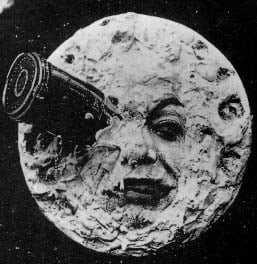 I enjoyed the story of the Oscar-winning film Hugo in its own right, but to me the most interesting aspect of the film is its exploration of the life and work of French film pioneer Georges Méliès. A fictionalized version of Méliès plays a central role in Hugo, and director Martin Scorsese recreates scenes from several of Méliès’s works.
I enjoyed the story of the Oscar-winning film Hugo in its own right, but to me the most interesting aspect of the film is its exploration of the life and work of French film pioneer Georges Méliès. A fictionalized version of Méliès plays a central role in Hugo, and director Martin Scorsese recreates scenes from several of Méliès’s works.
A biography of Méliès reveals that early in life he became a “theatrical showman whose performances revolved around magic and illusionist techniques which he studied while in London.” Seeing his first film in 1895, Méliès decided to become a filmmaker himself, so he built is own projector and even his own studio.
Méliès invented the “stop trick” of momentarily turning off the camera to make onscreen people and objects “disappear.” In addition, “He pioneered the first double exposure (La caverne Maudite, 1898), the first split screen with performers acting opposite themselves (Un Homme de tete, 1898), and the first dissolve [gradual transition from one scene to another] (Cendrillon, 1899).”
While Méliès faded into obscurity for many years and many of his films were melted down into shoes, he was rediscovered in his lifetime and his surviving films lovingly restored. Now many of his films, including his classic A Trip to the Moon of 1902, can be seen online.
Méliès vision helped launch a new artistic form. And—who knows—it might have even helped inspire the real-life moon landing that took place a mere three decades after his his death.
If you enjoyed this post, consider subscribing to The Objective Standard and making objective journalism a regular part of your life.
Related:
Image: Wikipedia


![[TEST] The Objective Standard](https://test.theobjectivestandard.com/wp-content/uploads/2017/10/logo.png)










